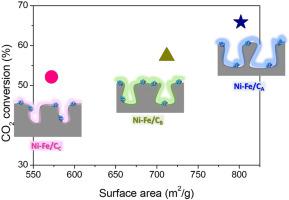Microporous and Mesoporous Materials ( IF 5.2 ) Pub Date : 2021-09-07 , DOI: 10.1016/j.micromeso.2021.111405 Miriam González-Castaño 1 , Juan Carlos Navarro de Miguel 2 , Jens-H. Boelte 3 , Miguel Angel Centeno 2 , Olaf Klepel 3 , Harvey Arellano-García 1

|
In heterogeneous catalysis, the benefits of employing adequate textural properties on the catalytic performances are usually stated. Nevertheless, the quantification of the extent of improvement is not an easy task since variations on the catalysts' specific areas and pore structures might involve modifications on a number of other surface catalytic features. This study establishes the impact of the catalyst textural properties on the CO2 methanation performance by investigating bimetallic Ni–Fe catalysts supported over carbon supports with different textural properties regarding surface area and pore structure. The comparable metal loading and dispersions attained for all systems enabled establishing forthright relationships between the catalyst textural properties and CO2 methanation rate. Once the influence of the external mass diffusions on the catalysts’ performance was experimentally discarded, the estimated Thiele modulus and internal effectiveness (φ and ηEff) values showed that the catalyst performance was majorly governed by the surface reaction rate whilst the pore size affected in no significant manner within the examined range (Dpore = 10.2 to 5.8 nm). Therefore, the rapport between the catalyst performance and surface area was quantified for the CO2 methanation reaction over Ni–Fe catalysts: increasing the surface area from 572 to 802 m2/g permit obtaining ca. 10% higher CO2 conversions.
中文翻译:

评估 Ni-Fe 催化剂的结构特性对 CO2 甲烷化性能的影响
在多相催化中,通常会说明在催化性能上采用足够的结构特性的好处。尽管如此,量化改进程度并不是一件容易的事,因为催化剂特定区域和孔结构的变化可能涉及对许多其他表面催化特征的修改。本研究通过研究负载在碳载体上的双金属 Ni-Fe 催化剂在表面积和孔结构方面具有不同的结构特性,从而确定了催化剂结构特性对 CO 2甲烷化性能的影响。所有系统获得的可比金属负载量和分散度能够在催化剂结构特性和 CO 2之间建立直接关系甲烷化率。一旦实验上排除了外部质量扩散对催化剂性能的影响,估计的蒂勒模量和内部有效性(φ 和 η Eff)值表明催化剂性能主要受表面反应速率控制,而孔径影响在检查范围内没有显着的方式(D孔 = 10.2 到 5.8 nm)。因此,对于 Ni-Fe 催化剂上的 CO 2甲烷化反应,催化剂性能和表面积之间的关系被量化:将表面积从 572 增加到 802 m 2 /g 允许获得约。CO 2转化率提高 10% 。



























 京公网安备 11010802027423号
京公网安备 11010802027423号